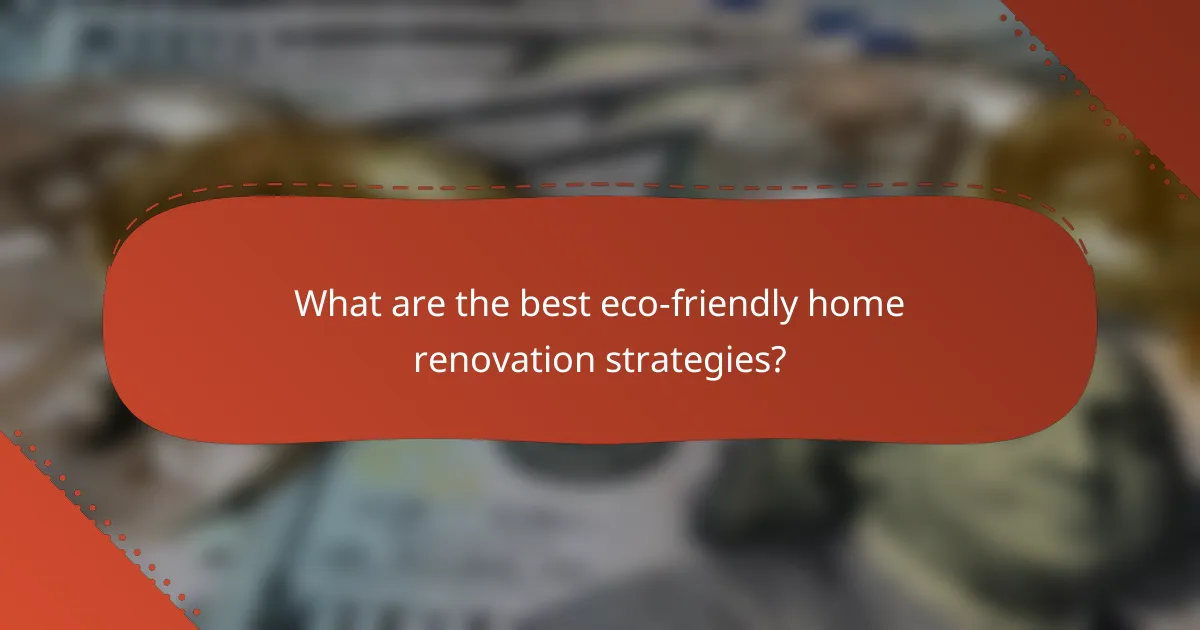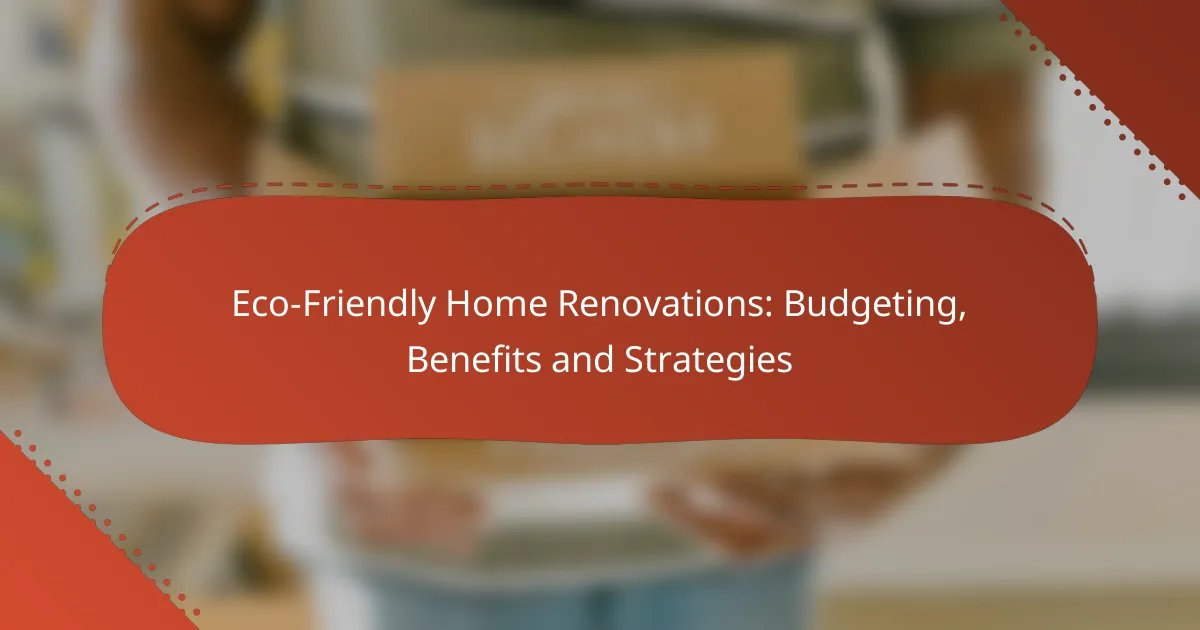Eco-friendly home renovations are an excellent way to enhance energy efficiency and reduce environmental impact while also saving money in the long run. By focusing on sustainable materials, water conservation, and smart technology, homeowners can create healthier living spaces that improve indoor air quality. Careful budgeting for these renovations ensures that they remain financially feasible while maximizing their benefits.

What are the best eco-friendly home renovation strategies?
The best eco-friendly home renovation strategies focus on enhancing energy efficiency, using sustainable materials, conserving water, integrating smart technology, and improving indoor air quality. These approaches not only reduce environmental impact but can also lead to long-term cost savings.
Energy-efficient upgrades
Energy-efficient upgrades include installing high-performance windows, adding insulation, and upgrading to energy-efficient appliances. These improvements can significantly lower energy consumption and utility bills.
Consider using Energy Star-rated products, which are designed to meet strict energy efficiency guidelines. For example, replacing old appliances with Energy Star models can reduce energy use by 10-50%.
Sustainable materials selection
Selecting sustainable materials involves choosing products that are renewable, recycled, or have a low environmental impact. Options include bamboo flooring, recycled metal roofing, and low-VOC paints.
When sourcing materials, look for certifications like FSC (Forest Stewardship Council) for wood products or Cradle to Cradle for a broader range of materials. This ensures that your choices support sustainable practices.
Water conservation techniques
Water conservation techniques can include installing low-flow fixtures, rainwater harvesting systems, and drought-resistant landscaping. These measures help reduce water usage and lower utility bills.
For instance, low-flow showerheads can reduce water flow by 30-50%, while rain barrels can collect thousands of liters of rainwater for irrigation, promoting sustainable water management.
Smart home technology integration
Integrating smart home technology can enhance energy efficiency and convenience. Smart thermostats, lighting systems, and energy monitors allow homeowners to optimize energy use based on real-time data.
For example, a smart thermostat can learn your schedule and adjust heating and cooling accordingly, potentially saving 10-20% on energy costs annually. Consider systems compatible with renewable energy sources for added benefits.
Indoor air quality improvements
Improving indoor air quality can be achieved through proper ventilation, using air purifiers, and selecting low-emission materials. This is crucial for creating a healthy living environment.
Consider installing an HRV (Heat Recovery Ventilator) to enhance airflow while minimizing energy loss. Additionally, using non-toxic paints and finishes can significantly reduce indoor pollutants, contributing to better health and comfort.

How to budget for eco-friendly renovations?
Budgeting for eco-friendly renovations involves estimating costs for sustainable materials, labor, and potential savings from tax credits. A well-planned budget helps ensure that your renovation is both environmentally friendly and financially feasible.
Estimate costs for materials
Begin by researching the prices of eco-friendly materials such as bamboo flooring, recycled glass tiles, or low-VOC paints. Costs can vary significantly, with sustainable options typically ranging from 10% to 30% more than conventional materials. Compare local suppliers to find the best prices and consider bulk purchasing to reduce expenses.
Keep in mind that investing in higher-quality materials may lead to long-term savings through durability and lower maintenance costs. Create a detailed list of required materials and their estimated costs to maintain clarity in your budget.
Plan for labor expenses
Labor costs for eco-friendly renovations can differ based on the complexity of the project and the expertise required. Hiring contractors experienced in sustainable practices may cost more upfront, but they can provide valuable insights and ensure compliance with green building standards. Expect to allocate around 20% to 35% of your total budget for labor.
Consider whether some tasks can be DIY to save on labor costs, especially for simpler projects like painting or landscaping. However, be cautious not to take on too much if you lack experience, as mistakes can lead to higher expenses in the long run.
Identify potential tax credits
Many governments offer tax credits or rebates for eco-friendly renovations, which can significantly reduce your overall costs. Research local and federal programs that apply to energy-efficient upgrades, such as solar panel installation or energy-efficient windows. In the U.S., for example, the federal tax credit for solar energy systems can cover a substantial percentage of installation costs.
Consult with a tax professional to understand eligibility requirements and ensure you maximize available incentives. Keeping thorough records of your renovation expenses will help when filing for these credits.
Set a contingency fund
Setting aside a contingency fund is crucial for any renovation project, including eco-friendly ones. A common recommendation is to allocate about 10% to 20% of your total budget for unexpected expenses that may arise during the renovation process. This can cover unforeseen issues like structural repairs or changes in material costs.
Having a contingency fund allows you to stay on track financially and avoid stress if unexpected challenges occur. Regularly review your budget and adjust the contingency amount as needed based on project developments.

What are the benefits of eco-friendly renovations?
Eco-friendly renovations offer numerous advantages, including cost savings, enhanced property value, improved health, and a smaller environmental impact. By adopting sustainable practices, homeowners can create a more efficient and healthier living space while contributing positively to the planet.
Lower utility bills
One of the most immediate benefits of eco-friendly renovations is the reduction in utility bills. Energy-efficient appliances, proper insulation, and solar panels can significantly lower electricity and heating costs. Homeowners may see savings of 20-30% on their monthly bills after implementing these upgrades.
To maximize savings, consider conducting an energy audit to identify areas where improvements can be made. Simple changes, such as switching to LED lighting or installing low-flow water fixtures, can also contribute to lower utility expenses.
Increased property value
Eco-friendly renovations can enhance property value, making homes more attractive to potential buyers. Properties with energy-efficient features often sell for higher prices, as buyers are increasingly looking for sustainable living options. Studies suggest that homes with green certifications can command a premium of 5-15% over traditional homes.
Investing in eco-friendly upgrades, such as energy-efficient windows or sustainable landscaping, not only improves comfort but also boosts resale potential. Highlighting these features during a sale can attract environmentally conscious buyers.
Healthier living environment
Eco-friendly renovations contribute to a healthier living environment by reducing exposure to harmful chemicals and improving indoor air quality. Using non-toxic materials, such as low-VOC paints and sustainable flooring, can create a safer home for residents.
Additionally, proper ventilation and moisture control can prevent mold growth and enhance overall comfort. Homeowners should prioritize natural materials and energy-efficient systems to foster a healthier indoor atmosphere.
Reduced carbon footprint
Implementing eco-friendly renovations helps reduce a home’s carbon footprint, contributing to environmental sustainability. By utilizing renewable energy sources, such as solar or wind power, homeowners can significantly decrease their reliance on fossil fuels.
Incorporating sustainable practices, like rainwater harvesting and composting, further minimizes waste and resource consumption. Homeowners should aim to choose materials and systems that prioritize sustainability to make a meaningful impact on the environment.

What are the prerequisites for eco-friendly renovations?
Eco-friendly renovations require careful planning and consideration of your home’s current energy efficiency, local building codes, and the expertise of eco-friendly contractors. Understanding these prerequisites helps ensure that your renovation is sustainable, compliant, and effective in reducing your environmental impact.
Assess current home energy efficiency
Evaluating your home’s energy efficiency is crucial before starting eco-friendly renovations. This assessment typically includes checking insulation, windows, heating and cooling systems, and appliances. Identifying areas of energy loss can help prioritize renovations that will yield the greatest energy savings.
Consider conducting an energy audit, which can cost between $100 and $500, depending on the size of your home. This audit will provide insights into where improvements are needed and may even qualify you for rebates or incentives from local utilities.
Research local building codes
Understanding local building codes is essential for any renovation project, especially for eco-friendly upgrades. These codes dictate what materials and methods are permissible, ensuring safety and compliance with environmental regulations. Familiarize yourself with any specific requirements related to energy efficiency and sustainable practices.
Check with your local building department or municipal website to find relevant codes. Some areas may offer incentives for using sustainable materials or energy-efficient systems, which can help offset renovation costs.
Consult with eco-friendly contractors
Working with contractors who specialize in eco-friendly renovations can significantly enhance the effectiveness of your project. These professionals are knowledgeable about sustainable materials, energy-efficient systems, and best practices for minimizing environmental impact. They can also help navigate local codes and regulations.
When selecting a contractor, look for certifications such as LEED (Leadership in Energy and Environmental Design) or similar credentials. Obtain multiple quotes and ask for references to ensure you choose a contractor who aligns with your eco-friendly goals.
